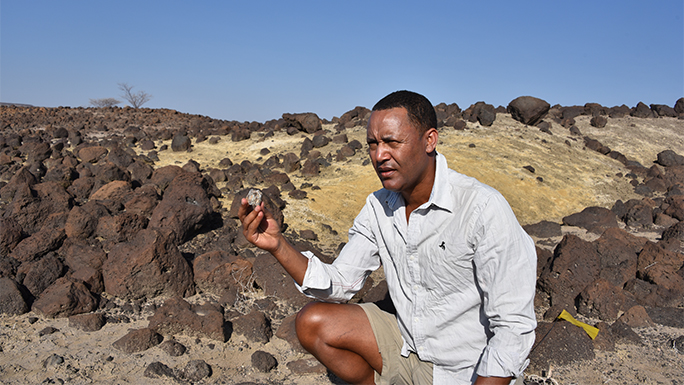Ancient hominins had small brains like apes, but longer childhoods like humans
Human ancestors that lived more than 3 million years ago had brains that were organized like chimpanzee brains, but had prolonged brain growth like humans, new research from the University of Chicago and other leading institutions shows.
That means these hominins — the species Australopithecus afarensis, made famous by the Lucy and Dikika child fossils found in Ethiopia — had a mosaic of ape and human features, a hallmark of evolution.
By using precise technology to scan eight fossil skulls from this region, the researchers also resolved a longstanding question of whether this species had prolonged childhood, a period of time unique to humans that allows us to learn and grow.
“As early as 3 million years ago, children had a long dependence on caregivers,” said Zeresenay (Zeray) Alemseged, PhD, Donald N. Pritzker Professor of Organismal Biology and Anatomy and senior author of the research, published April 1 in the journal Science Advances. “That gave children more time to acquire cognitive and social skills. By understanding that childhood emerged 3.5 million years ago, we are establishing the timing for the advent of this milestone event in human evolution.”

Alemseged, who discovered the Dikika child fossil in 2000 and leads the Dikika field project in Ethiopia, has studied its species for decades and helped design the new research. Widely accepted to be ancestral to all later hominins, including humans, Australopithecus afarensis lived in East Africa more than 3 million years ago and had many human-like features: They walked upright, had brains that were 20% larger than chimpanzees and may have used sharp stone tools.
But many questions about the species remain unresolved, including whether its brain was organized like humans — which could indicate more complex behaviors, like communication — and whether it also had protracted brain growth.
This fossil has played a pivotal role in allowing paleoanthropologists to ask and answer several major questions about how we became human.When Alemseged discovered the Dikika child, he used a CT scan to examine its skull, and by studying its teeth determined that its age at time of death was around 3 years. To understand how the child’s brain was organized, however, he needed more precise imaging technology, so his team used synchrotron-computed tomography — which uses extremely powerful X-rays to reveal detailed information about a material’s structure — to scan the child’s skull and seven other skulls from the same region.
While brains do not fossilize, they do leave imprints on the inside of the skull. With the scans, the researchers could measure endocranial volume, and see the placement of the lunate sulcus — a fissure that separates the anterior and posterior parts of the brain. This placement differs in humans and chimpanzees — in humans, who have a large prefrontal cortex, the fissure is pushed further down in the brain. In chimpanzees, the fissure is closer to the front. The scans revealed that Australopithecus afarensis had a lunate sulcus in a similar position to the fissure found in chimpanzee brains.
“This resolves a contentious argument that has polarized paleontologists for years,” Alemseged said. “We can now say the organization of the brain was more ape-like.”
Did that mean that the species acted more like chimpanzees? Not necessarily. The group of researchers also used synchrotron-computed tomographic scans to count the Dikika child’s dental growth lines. Similar to growth rings in trees, these growth lines can show the exact birth and death date of the child. The team’s dental experts then calculated the child’s age as 2.4 years.
“That allows you to ask how much of the brain was formed at that given age,” Alemseged said.
When researchers compared the child’s endocranial volume to that of a chimpanzee and humans, they found that brain development in Australopithecus afarensis was protracted, like in humans today. That meant the species had a long childhood, which laid the foundation for subsequent evolution of the brain and social behavior that differentiates humans today.
Alemseged’s collaborators on this research were from the Max Planck Institute for Evolutionary Anthropology, Florida State University, the School for Advanced Research, the European Synchrotron Radiation Facility, Griffith University, Arizona State University, the Natural History Museum of London, and University College London.
The Dikka child, known as Selam (which means “peace” in the Ethiopian Amharic language), has been the source of several important papers on human evolution. Alemseged’s graduate students are still studying the fossil, looking at the development of its face and shoulder growth. Ultimately, Alemseged hopes to compile everything that he and his lab have discovered about the fossil into one compendium.
“This fossil has played a pivotal role in allowing paleoanthropologists to ask and answer several major questions about how we became human,” he said.
"Australopithecus afarensis endocasts suggest ape-like brain organization and prolonged brain growth" was published April 1 in Science Advances.
